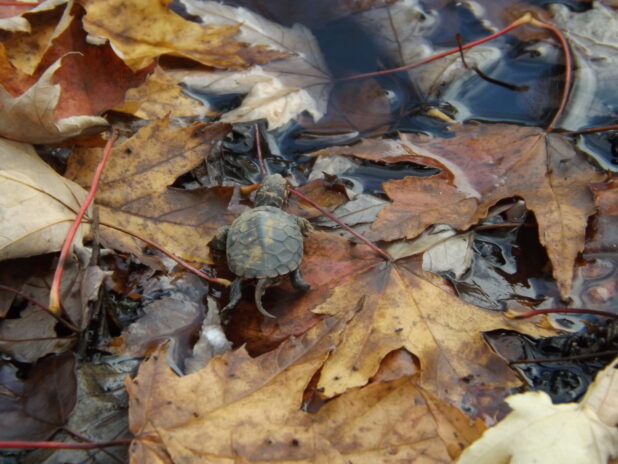Headline News
Turtle populations important to Ontario’s wetlands
October 17, 2023

By Kaitlin Sylvester
Ontario, a province known for its stunning natural landscapes and abundant biodiversity, is home to a remarkable treasure hidden within its wetlands – the turtle populations. These wetlands, primarily located within the boreal forest, are not just picturesque landscapes but play a crucial role in maintaining the ecological balance and contributing to the conservation of Canada’s natural heritage. As we explore the significance of turtle populations in Ontario’s wetlands, we uncover a web of interconnected benefits.
To comprehend this relationship, it’s essential to first understand the uniqueness of Canada’s boreal wetlands. These ecosystems, seasonally or permanently water-saturated, are an intrinsic part of Canada’s identity. More than two-thirds of the boreal forest is draped in wetlands, making it a water-dominated wonderland. These areas are characterized by their adaptability to wet conditions, being home to an array of plants and trees that thrive in the environment, such as shrubs, grass, sedge, and moss. What sets boreal wetlands apart is their high connectivity, allowing water and nutrients to flow over long distances, making them vulnerable to development that disrupts this natural flow.
Canada’s boreal forest, where the majority of these wetlands are nestled, holds a significant responsibility in global conservation efforts. These wetlands are home to 25 per cent of the world’s wetlands, serving as critical reservoirs of clean water and biodiversity. By conserving these vital habitats, we address multiple environmental challenges simultaneously. The world is currently grappling with a biodiversity crisis, with species going extinct at a rate 1,000 times higher than the historic norm, while climate change continues to accelerate. Canada’s commitment to tackling climate change and preserving biodiversity aligns perfectly with the potential of its wetlands.
More than just scenic landscapes, wetlands in Canada are integral to achieving climate and biodiversity goals. Not only do they store vast amounts of carbon, making them essential in mitigating climate change, but they also act as nature’s water purifiers, filtering out contaminants and reducing the frequency and severity of droughts and floods when left undisturbed. Furthermore, wetlands serve as biodiversity hotspots, supporting numerous plant and wildlife species. In essence, protecting wetlands is akin to conserving an entire ecosystem, yielding a multitude of benefits through a single act of conservation. And Canada, with its vast boreal forest, has the unique opportunity to lead the charge in wetland preservation.
The importance of wetlands extends to Hastings Highlands specifically, where they play a pivotal role in maintaining the ecological health of the region. Currently, Ontario is home to around 25 per cent of all the wetlands in Canada and 6 per cent of wetlands globally. These wetlands are bustling with life, but it’s the turtle populations that stand out as unsung heroes in preserving the integrity of these fragile ecosystems.
Turtles have a significant impact on the health of the Hastings wetlands. One of the lesser-known roles of turtles is their contribution to water quality. These creatures play a vital role in maintaining clean and safe water by removing harmful bacteria sources. Turtles are scavengers and consume the carcasses of fish and animals that perish in lakes and wetlands. This scavenging behavior prevents the proliferation of disease-causing bacteria, thereby ensuring that the water remains suitable for a variety of aquatic life.
Moreover, turtles are instrumental in preserving fish habitats and wetland areas. As turtles age, their diet shifts towards seeds and plant matter, rather than protein. In doing so, they help cycle nutrients in their guts and shells. Seeds ingested by turtles get transported to new areas as the turtles move through their territories, encouraging the growth of new vegetation. In essence, turtles act as nature’s gardeners, spreading biodiversity within wetland habitats.
Turtles have a profound impact on the biodiversity of Hastings wetlands and play a vital role in supporting the region’s fish and wildlife. Over 70 per cent of Ontario’s wildlife depends on wetlands and shorelands and the presence of turtles in these ecosystems is a testament to their importance in maintaining a balanced and thriving environment. It’s not just the wetlands that benefit from the presence of turtles; human wellbeing is also intrinsically linked to the health of these ecosystems. Healthy wetlands support clean water, which is a fundamental resource for communities across the province.
However, the survival of turtle populations in Ontario is not without its challenges. Turtles, like many other wetland species, are mobile and often need to travel great distances in search of food and suitable breeding habitats. This mobility makes them vulnerable to various threats that could jeopardize their survival. Conserving turtle populations in Hastings wetlands is a shared responsibility that involves both public awareness and active intervention.
Think Turtle Conservation Initiative, founded in 2018, plays a crucial role in the conservation efforts. Founder Kelly Wallace says the 2023 season has been the lowest instance of injured turtles she’s seen during her tenure and goes on to note that “by helping one species, we’re helping the whole ecosystem.”
For anyone who comes across an injured or physically challenged turtle, especially late in the season or over the winter, it is essential to contact the Ontario Turtle Conservation Centre at 705-741-5000. They are located in Peterborough and admit turtles from all across Ontario.
The active involvement of organizations like the TTCI and OTCC is crucial in ensuring the survival of these remarkable species and the preservation of Hastings Highlands wetlands.
The importance of turtle populations to Ontario’s wetlands cannot be overstated. They are the custodians of water quality, the nurturers of biodiversity, and the unsung heroes of the province’s ecosystems.




















